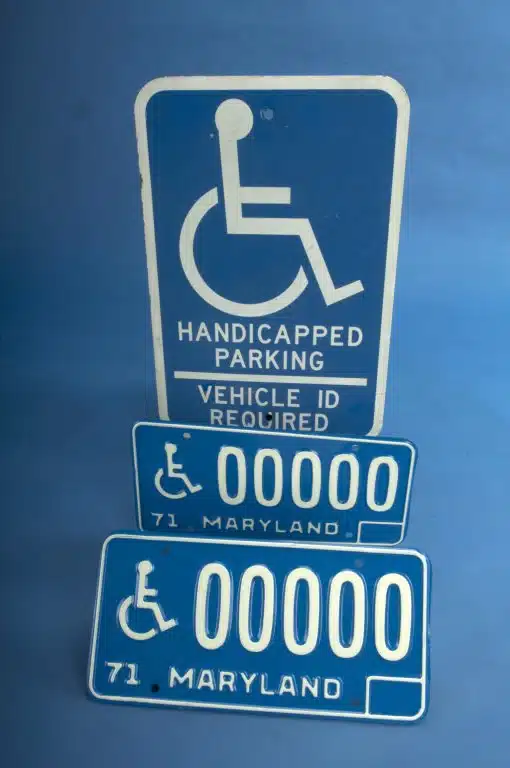RECENT POSTS
Categories
The Evolution of Accessibility: When Did Handicap Parking Start?
Imagine the frustration and despair of circling a parking lot, searching for a spot that doesn't seem to exist. For individuals with disabilities, this scenario is more than just an inconvenience; it's a daily challenge that can turn a simple errand into an ordeal. The struggle to find accessible parking is not just about convenience; it's about dignity, independence, and the basic right to access public spaces. The history of handicapped parking tags, deeply rooted in the broader narrative of disability rights and accessibility legislation in the United States, is a testament to this ongoing battle for equality and recognition.
This blog will explore when handicapped parking first started, tracing its evolution from its inception to the present day, with a special focus on the Americans with Disabilities Act (ADA). This pivotal legislation has played a crucial role in shaping the landscape of disability rights, transforming parking lots from daunting obstacles to accessible gateways.
The History of Handicapped Parking Tags
The journey of handicapped parking tags is a poignant chapter in the broader narrative of disability rights and accessibility. This history is not just a timeline of policy changes; it's a reflection of society's evolving understanding and acknowledgment of the needs of individuals with disabilities.
Early Developments
The idea of reserved parking for people with disabilities began to gain traction in the U.S. after World War II, as veterans returned home with disabilities. However, these early efforts were sporadic and not standardized.
1960s and 1970s
The disability rights movement gained momentum during the 1960s and 1970s. This period saw a growing recognition of the need for greater accessibility in public spaces for individuals with disabilities. The concept of designated parking spaces started to become more common, although there was still no standardized system.
The Rehabilitation Act of 1973
This act was a significant step forward in disability rights in the U.S. Section 504 of this act was the first U.S. federal civil rights protection for people with disabilities. While it didn't specifically mandate disabled parking permits, it set the stage for accessibility as a civil right.
The 1980s - Standardization Begins
The 1980s saw more concerted efforts towards standardizing disabled parking across the United States. The issuance of placards or special license plates for individuals with disabilities became more common. These placards or plates were recognized and could be used in various jurisdictions, providing greater mobility and accessibility for disabled individuals.
The Americans with Disabilities Act (ADA) of 1990
This landmark legislation represented a major advancement in disability rights. It required accessible parking spaces in public and private parking lots, clearly defining the size and nature of these spaces. The ADA also mandated the use of the International Symbol of Accessibility (ISA), the familiar blue-and-white wheelchair symbol.
Post-ADA Developments
Since the passage of the ADA, there have been ongoing efforts to refine and enforce regulations regarding disabled parking. This includes addressing issues like abuse of handicapped parking permits and ensuring adequate enforcement of parking regulations.
The history of handicapped tags in the U.S. reflects broader societal changes in understanding and accommodating people with disabilities. From a fragmented beginning, it has evolved into a well-defined system aimed at ensuring equal access and mobility for all individuals, regardless of their physical abilities.
Types of Handicapped Parking Tags
Understanding the different types of handicapped parking tags is crucial for individuals and organizations seeking the appropriate permits. Each type caters to specific needs and circumstances, ensuring that the provision of accessible parking is both inclusive and practical.
Permanent Tags:
Purpose and Eligibility: Permanent tags are designed for individuals with long-term disabilities, generally characterized as those not expected to improve significantly over time and dealing with substantially impaired mobility.
Duration and Renewal: Although termed 'permanent', these tags typically have an expiration date, often coinciding with the expiration of the holder's driver's license or state ID. Renewal procedures usually require a new application, but not always a new medical certification.
Features: The color scheme for handicap placards often differs by state, but typically, permanent placards are blue or dark blue, signifying a long-term disability. In contrast, temporary placards are usually red or another color that clearly distinguishes them from permanent ones, indicating a short-term disability. This color coding helps law enforcement to quickly identify the type of permit and the duration of its validity.
Temporary Tags:
Purpose and Eligibility: Temporary tags are intended for individuals with short-term disabilities or those recovering from surgery or an injury. Short-term disabilities are those that significantly impair mobility but are expected to improve over time.
Duration: The validity of temporary tags is limited, usually ranging from six months to a year, depending on the state's regulations and the medical professional's assessment.
Renewal: If the disability extends beyond the initial validity period, a new application and medical certification may be required for renewal.
Organizational Tags:
Purpose and Eligibility: These tags are available for organizations, such as care facilities, hospitals, or transportation services, that transport individuals with disabilities.
Usage: Organizational tags are used for vehicles specifically designated for transporting multiple individuals with disabilities. They are not assigned to a single individual but to the vehicle itself and are usually green or another color to separate it from permanent and temporary handicap placards.
Application Process: The process typically involves the organization providing proof of its services and the necessity for such a tag in its transportation operations.
Each type of disabled parking permit serves a distinct purpose, reflecting the diverse needs of individuals with disabilities. Understanding these differences is key for applicants to ensure they receive the appropriate type of tag that aligns with their specific circumstances. This system of categorization helps streamline the process and ensures that the allocation of handicapped parking spaces meets the actual needs of the community.
Obtaining a Handicapped Parking Tag
The process of obtaining a handicapped parking tag, while standardized in many respects due to the ADA, can still vary based on state-specific regulations. Understanding this process is crucial for individuals who require these tags due to mobility impairments or other qualifying disabilities. Keep in mind that specific requirements can vary by state, so it's important to check with your local Department of Motor Vehicles (DMV) or equivalent agency for exact details. Here's a general guide:
1. Determine Your Eligibility
The first step in obtaining a handicapped parking tag involves understanding the eligibility criteria. Generally, these criteria include a wide range of physical impairments that substantially limit one's mobility, such as an inability to walk without assistance, a condition that impairs the ability to walk certain distances, or visual impairments. Some states also consider conditions that may not immediately impair mobility but could be exacerbated by long distances, such as heart or lung conditions.
2. The Application Process
Application Form: Individuals seeking a handicapped parking tag must complete an application form, which is typically available through the state's Department of Motor Vehicles (DMV) or a similar agency.
Medical Certification: Most applications require a certification from a licensed healthcare professional. This certification must verify the applicant's disability and the necessity of a handicapped parking tag. Always check with your local DMV to ensure you take the correct form to your doctor; some states might have a section on the same form as your application whereas other states might have a completely different form altogether.
Submission and Fees: Once completed, the application, along with any required fees, must be submitted to the designated state agency. Some states may offer the option to apply online or by mail.
3. Renewal and Replacement
Handicapped parking tags are not permanent and require renewal upon expiration. The renewal process typically involves submitting a renewal application, which may or may not require another certification from a healthcare professional. In cases of lost, stolen, or damaged tags, most states have a replacement process that can be initiated through the issuing agency.
The development of handicapped parking tags represents a significant chapter in the ongoing narrative of disability rights and accessibility. From the initial steps taken to address the needs of disabled veterans to the comprehensive framework established by the Americans with Disabilities Act, this evolution reflects a growing societal commitment to inclusivity and equality.

Facing a Denied Disability Claim? Let Wettermark Keith's Experts Assist You
Wettermark Keith strives to not only navigate the legal complexities on behalf of our clients but also to empower them with knowledge and resources. Our firm is dedicated to guiding clients through the complexities of the appeals process, ensuring they receive the support and representation needed to challenge unjust denials. While our scope is specifically tailored to disability claim denials, we are committed to providing our clients with the necessary information and resources related to their disability rights.
At Wettermark Keith™, we have an excellent reputation as one of the most accomplished personal injury firms in the country. We offer a diverse range of practice areas, including personal injury cases, auto wrecks, trucking wrecks, nursing home abuse, medical malpractice, on-the-job injuries, social security, and VA disability, to name just a few. At Wettermark Keith, we believe in taking cases personally. Our purpose is to practice with care and compassion - to tell our clients' stories and make their voices heard. We achieve this by building strong relationships based on constant communication and an unwavering dedication to truth and trust.
Frequently Asked Questions
Delaware's groundbreaking move in 1955 with the passage of Code 2134 marked a pivotal moment in the history of disability rights and accessibility in the United States. This legislation, the first of its kind, laid the groundwork for recognizing the necessity of designated parking spaces for individuals with disabilities. It was a forward-thinking step, acknowledging the challenges faced by this community and setting a precedent for other states.
This early legislation eventually paved the way for more comprehensive measures, culminating in the Americans with Disabilities Act (ADA) of 1990, which established uniform standards for handicapped parking across the nation. Delaware Code 2134 stands as a testament to the evolving understanding and accommodation of the needs of people with disabilities, reflecting a growing societal commitment to inclusivity and equality.
A handicapped parking tag is generally issued to an individual with a disability and not to a specific vehicle - this means the tag can be used in any vehicle that the person with the disability is either driving or is a passenger in. However, it's important to display the tag correctly as per the state's guidelines, usually hanging it from the rearview mirror or placing it on the dashboard.
Penalties for misuse or fraud of handicapped parking tags vary by state but can be quite severe. They can include hefty fines, community service, and in some cases, jail time. Misuse can involve using someone else's tag or using a tag without the person with the disability present. Fraud can include forging a tag or doctor's note to obtain one. States take these violations seriously to protect the rights of those with legitimate needs.
Once you obtain your handicapped parking tag, it is valid and recognized in all 50 states across the U.S., enabling you to utilize handicapped parking spaces even when you are outside your home state. However, when traveling to other states, it's important to familiarize yourself with the specific local regulations of the state you are visiting, as there may be variations in reciprocity and parking rules that could affect how you use your tag. This precaution ensures that you remain compliant with different state laws and can make the most of the accessibility options available to you.
Choosing between a handicapped placard for your mirror and a handicapped license plate largely depends on your lifestyle and transportation habits. Placards offer flexibility, as they can be easily moved between different vehicles and are ideal for individuals who travel in multiple cars or who are often passengers. They are highly visible when hung from the rearview mirror and are relatively easy to obtain. On the other hand, handicapped license plates are permanently affixed to one vehicle, providing convenience as there's no need to remember to display or remove them. They are less prone to theft and are suitable for those who primarily use a single vehicle for their transportation needs. Some individuals may even opt for both, using the placard in secondary vehicles or when traveling with others. The right choice comes down to your own transportation situation and needs. Both placards and plates legally provide parking access and other privileges to assist those with disabilities.
The primary distinction between permanent and temporary handicapped tags lies in their duration and the nature of the disability they accommodate. Permanent tags are intended for individuals with long-term or chronic disabilities and typically align with the holder's driver's license or state ID expiration, often valid for several years and renewable.
In contrast, temporary tags are issued for short-term disabilities, such as recovery from surgery or injuries, with a validity period usually ranging from six months to a year, and require a new application for extension beyond their initial expiration. This differentiation ensures that the specific mobility needs of individuals with varying conditions are appropriately met. It is important to check with your local state DMV or agency to see what the specific rules are for obtaining and keeping a handicapped tag.
To obtain a disabled parking permit, check your eligibility based on state-specific criteria for mobility impairments or health conditions. You can acquire the application form from your local Department of Motor Vehicles (DMV) or their website, and part of this application will require medical certification from a licensed healthcare provider. After completing and submitting the form to the DMV, either in person, by mail, or online, and paying any applicable fees, you will receive your permit, which could be a placard or a special license plate. Be sure to familiarize yourself with the rules for using the permit, including parking regulations and renewal procedures, as these can vary by location.
Ready to work together? Contact us today for a free consultation.
HERE'S WHAT TO DO NEXT
If you or a loved one have been injured and think you might have a case, call us now for a free consultation.


